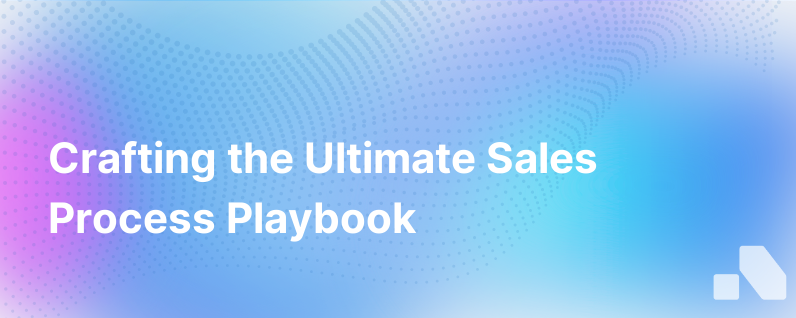
Creating an ultimate sales process playbook is akin to laying the foundation of a building. Without a robust framework, even the most enthusiastic sales efforts can falter. A detailed playbook ensures that sales teams have a definitive guide to turn prospects into loyal customers effectively and consistently.
The sales process playbook is not merely a document but a dynamic blueprint that combines strategy, tactics, and insights. It encapsulates the sum of your company's sales wisdom, best practices, and customer-centric selling approaches, distilled into an actionable manual. It's vital in scaling sales efforts and ensuring that all team members are aligned in their approach to pipeline management and deal closure.
In this article, we'll explore how to create a sales process playbook that is both comprehensive and flexible, and that applies to startups, mid-size companies, or enterprise-level sales organizations.
Step 1: Define Your Sales Methodology
First and foremost, be clear about the sales methodology your organization adheres to. Whether it's SPIN Selling, the Challenger Sale, Solution Selling, or any other approach, this decides the overall structure of your playbook.
Understand Buyer Personas: Clearly define who your target customers are, what issues they face, what motivates their purchasing decisions, and how they typically move through the sales funnel.
Tailor Sales Stages: Based on the chosen methodology and buyer personas, outline the stages of your sales process - from prospecting to nurturing to closing to post-sale follow-up.
Step 2: Break Down Each Stage of the Sales Process
Elaborate on the activities required at each stage of the sales process, provide examples and detailed descriptions of each step, and mention the expected outcomes.
Prospecting:
- Defining ideal customer profiles
- Lead generation tactics
- Research tools and processes
Qualifying:
- Criteria for lead qualification
- Discovery call outlines
- Sample qualifying questions
Presentation:
- Features and benefits alignment
- Case study usage
- Handling objections
Closing:
- Negotiation strategies
- Closing techniques
- Legal and compliance checks
Post-sale:
- Handover to account management/customer success
- Upselling and cross-selling opportunities
- Requesting referrals and case studies
Step 3: Incorporate Tools, Technologies, and Resources
In today’s tech-enabled sales landscape, align your playbook with the tools and technologies used in your sales stack. Detail how CRM platforms, sales enablement tools, communication software, and other technologies fit into each stage of the sales cycle for efficiency and effectiveness.
Step 4: Embed Training Material and Content
Ensure your playbook serves as a repository for sales collateral, including call scripts, email templates, presentation decks, proposal guidelines, and pricing sheets. This not only streamlines the sales process but also ensures consistency in communication.
Step 5: Script the Common Scenarios
Sales reps face a variety of situations with prospects. For each potential scenario, script out possible responses, stances, and strategies.
For example:
- Objection Handling Scripts
- Competitive Battlecards
- FAQs and their best responses
- Follow-up strategies
Step 6: Illustrate with Real-world Examples
Enhance your playbook with real-world case studies and examples of closed deals, including 'what worked' and 'lessons learned'. This allows sales reps to understand the concepts in a practical context.
Step 7: Define Metrics and KPIs
A good sales playbook should make it clear how success is measured. Include key performance indicators (KPIs) for sales activities and results, and clarify how performance will be tracked and reported.
Step 8: Encourage Collaboration and Peer Learning
Facilitate a culture where sales reps share their success stories, tips, and best practices. Encourage them to contribute to the playbook, making it a living document that evolves with experience.
Step 9: Review, Refine, and Update
The sales environment is dynamic; hence your playbook must be reviewed and updated periodically to incorporate market changes, product updates, customer feedback, and sales effectiveness insights.
Step 10: Ensure Accessibility and Training
Finally, make the playbook accessible to all relevant team members and provide ongoing training to ensure that your sales team can leverage it effectively.
An Example from the Tech Sector
Imagine you are a cloud storage company selling to SMBs. Your sales process will likely involve educating prospects about the benefits of cloud storage over traditional methods, demonstrating ease of transition, and allaying security concerns.
In this context, your playbook would open with a strong narrative about market trends in data storage, followed by a deep dive into identifying prospect pain points, such as cost concerns, data security, and workflow interruption. You would then provide the exact conversational pathways and resources that help address these pain points and progress the sale.
For instance, when facing security objections, your playbook might arm the sales rep with a detailed whitepaper on the encryption and security protocols you employ, past customer testimonials emphasizing reliability, and a walkthrough guide on the migration process to emphasize ease of transition.
In the technology sales arena, the playbook can also include a section on navigating the procurement processes within different types of organizations, which tends to be more complex.
Wrapping It Up
In crafting the ultimate sales process playbook, the goal is to create a resource that is not only informative but also inspiring and empowering. It should be a document that your sales team feels confident in and empowered by. After all, it's not just about making sales; it's about making successful sales professionals who feel equipped to face any selling scenario.
Remember, a playbook is a living document, and the sales landscape is an ever-changing field; the two must evolve together. Ensure your team is constantly learning, adapting, and refining your sales process for optimum results.
While we've focused on the how-to aspect of creating this playbook, tools like Aomni can be employed in your sales process to boost efficiency, precision, and sales success, helping your team to adapt and use the playbook in real-time scenarios.